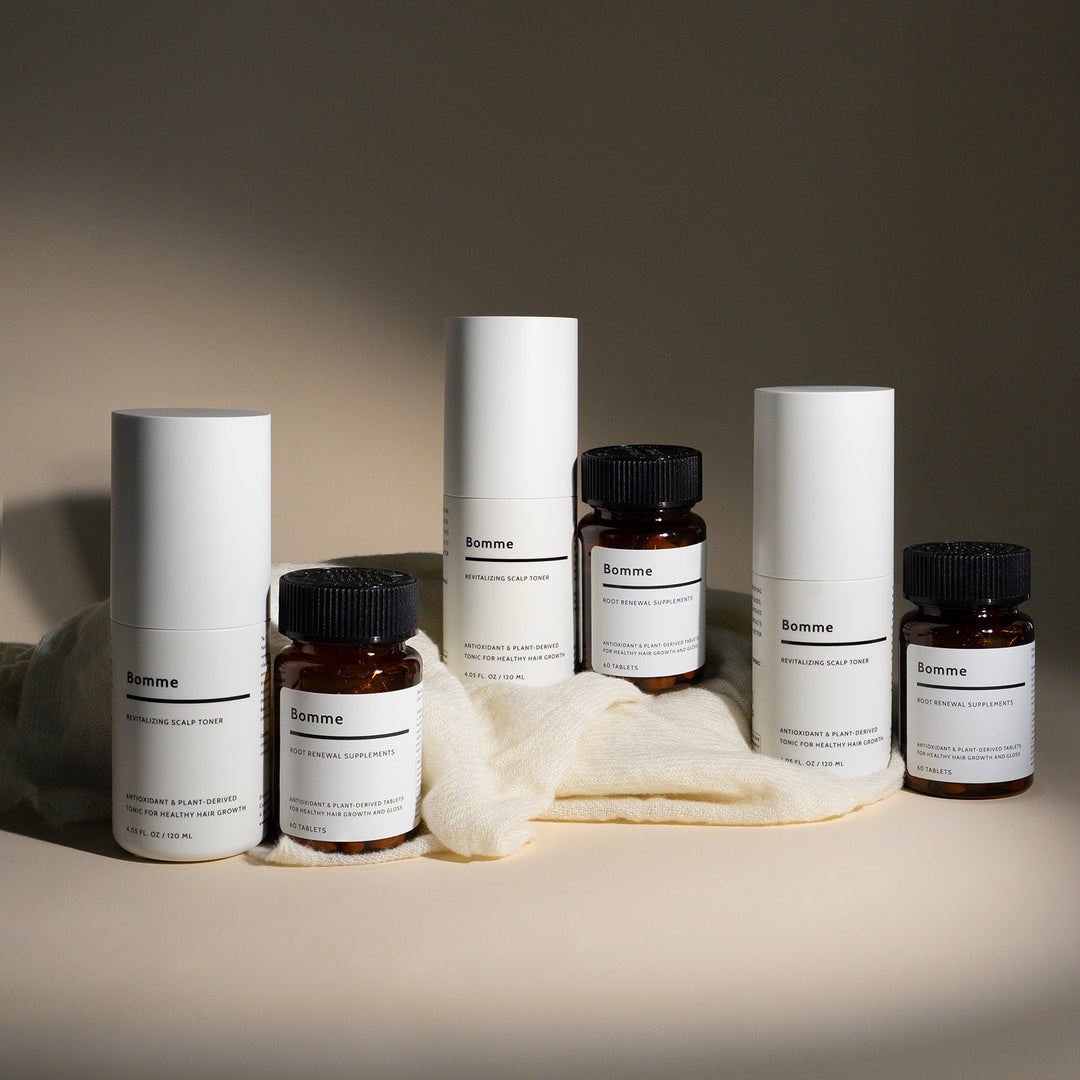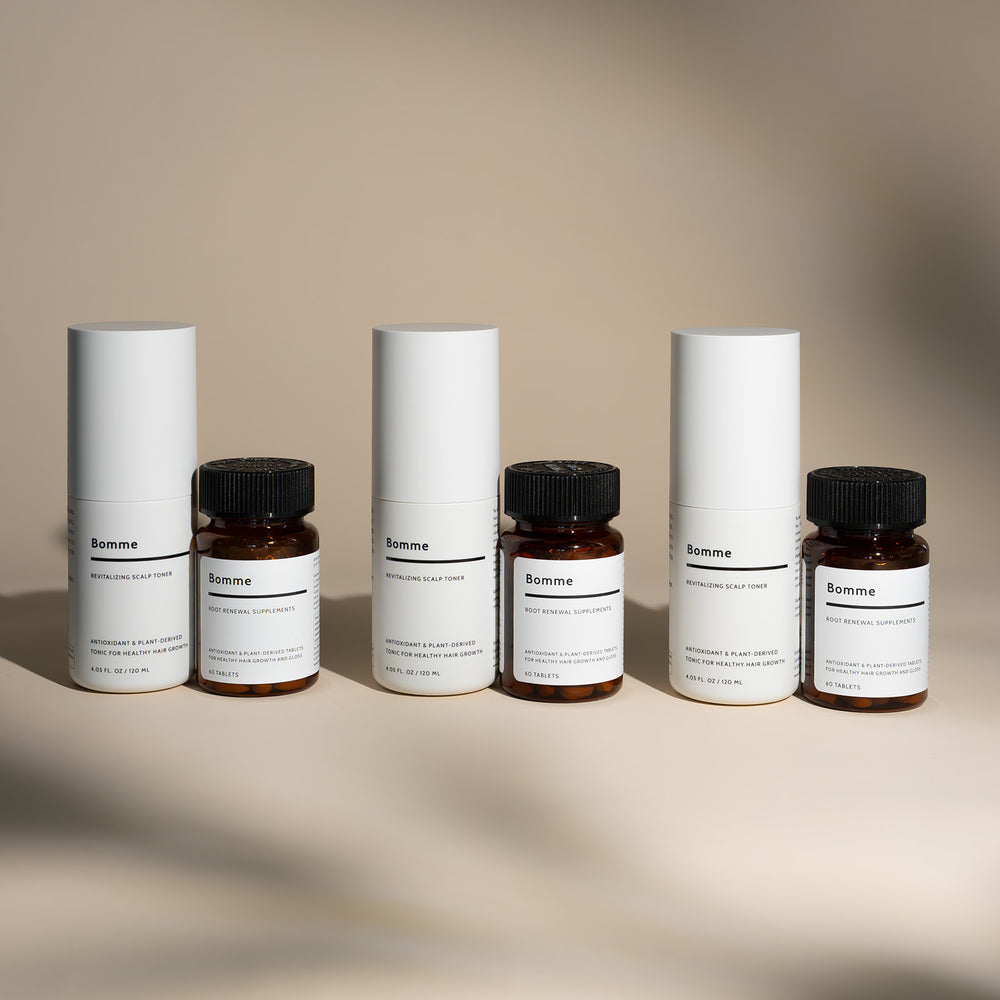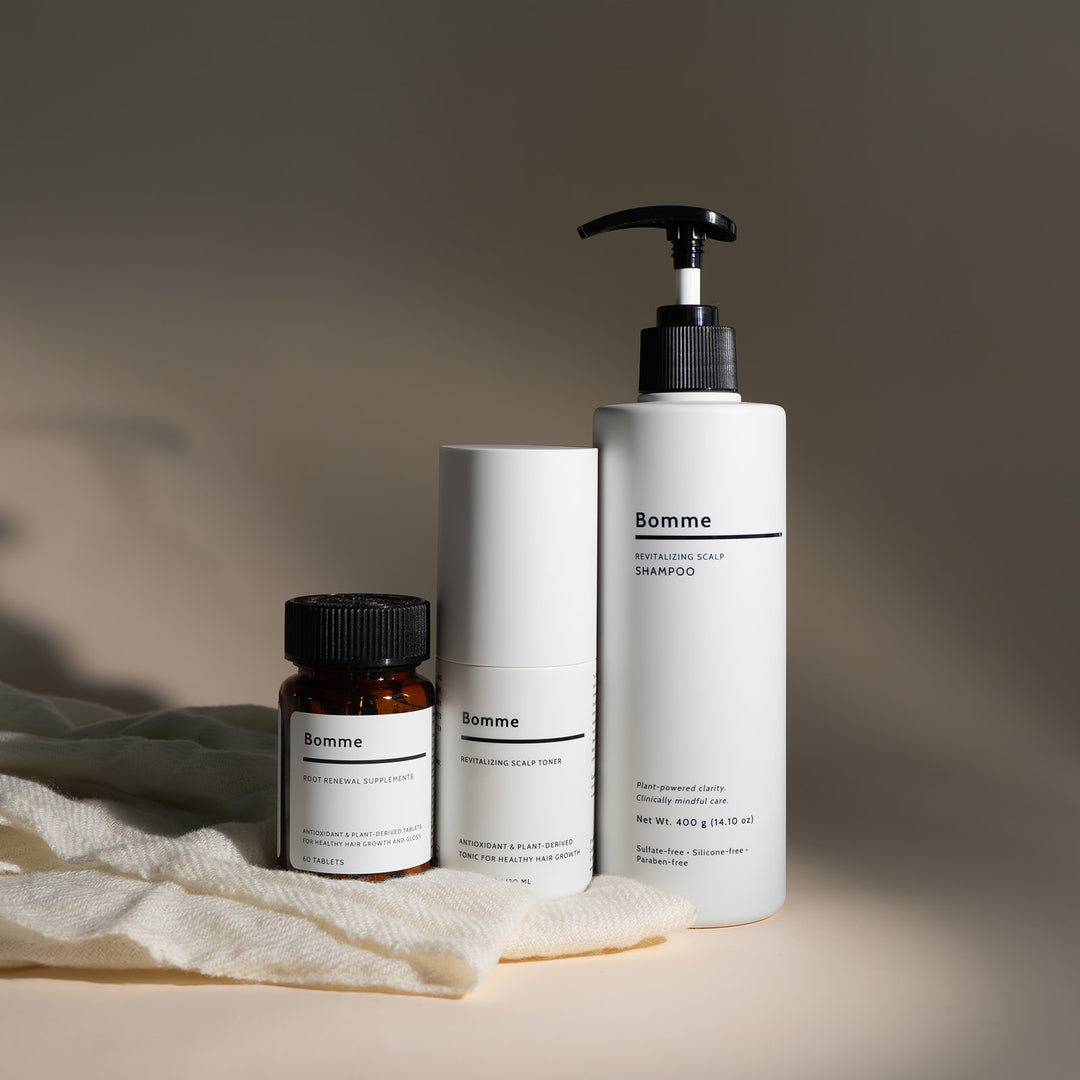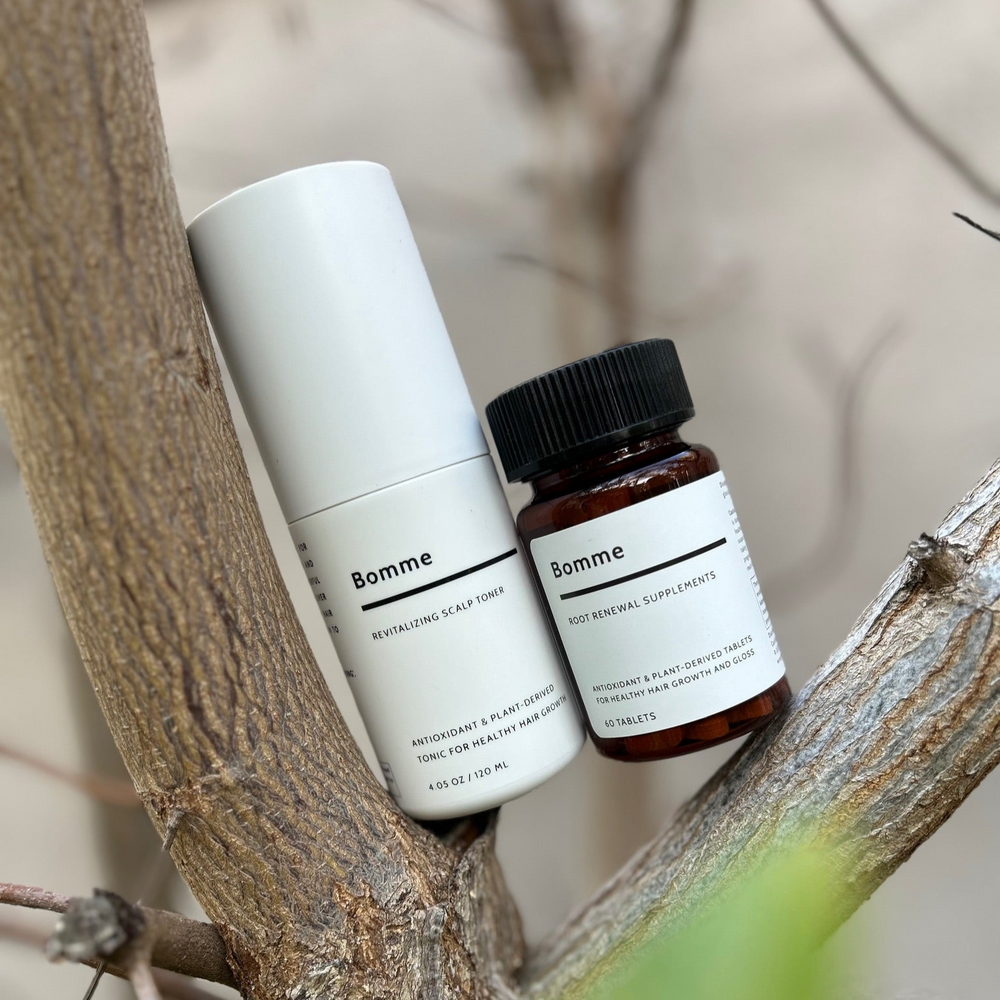FAQ
Last updated: Aug 30, 2025
Important: The information below is for educational purposes and does not replace medical advice. These products are not intended to diagnose, treat, cure, or prevent any disease. Consult your healthcare provider, especially if you are pregnant/nursing, have a medical condition, or take medications.
Root Renewal Supplements
Are Bomme’s Root Renewal Supplements effective?
In a 24‑week, randomized, double‑blind, placebo‑controlled clinical trial published in Skin Research & Technology (2023), participants who took the BLH308 supplement formula showed statistically significant improvements in hair density and thickness versus placebo. Some participants reported noticing changes by 8 weeks, with greater changes at 16 and 24 weeks. Individual results vary and depend on factors such as genetics, health status, and consistency of use.
What are the key ingredients?
Bomme’s Root Renewal Supplements feature a blend of:
-
Persimmon Leaf Extract (PLE): Antioxidant that helps defend against oxidative stress.
-
Green Tea Extract (EGCG‑rich): Antioxidant that supports healthy cell turnover.
-
Sophora Japonica Fruit Extract: Supports vascular health and provides anti‑inflammatory benefits.
How are these supplements different from hair‑growth medications?
Conventional medications (e.g., DHT‑targeting drugs): Often work by inhibiting 5‑alpha‑reductase, the enzyme that converts testosterone to DHT. This direct hormonal mechanism may be associated with hormone‑related side effects for some users.
Bomme approach: Our formula is designed to support a healthy scalp environment by helping normalize pathways related to 5‑alpha‑reductase expression in dermal papilla cells and by addressing inflammation. It is not a pharmaceutical 5‑alpha‑reductase inhibitor.
Why does inflammation matter for hair?
Chronic, low‑grade inflammation around hair follicles is linked to thinning and miniaturization. Pro‑inflammatory cytokines—such as IL‑6—can contribute to a less hospitable environment for robust hair growth. Bomme’s antioxidant‑rich ingredients are formulated to help reduce oxidative stress and support a calmer scalp environment.
What are the side effects?
The formula is generally well‑tolerated in healthy adults. As with any supplement, sensitivities can occur (e.g., mild GI upset, headache, skin flushing). Discontinue use and consult a healthcare professional if you experience redness, swelling, itching, or other concerning symptoms. Keep out of reach of children.
How should I take the supplements?
-
Dose: Take two tablets daily.
-
Timing: Consistency matters; take them at the same time each day. You may take with or without food according to your tolerance.
-
Duration: Use daily for 1 to 3 months for best assessment of results, then continue for maintenance if desired.
Are Bomme supplements for men or women?
Both. The formula is suitable for adults of all genders.
Do the supplements contain any drugs?
No. They are plant‑based dietary supplements, not prescription drugs.
Do the supplements expire?
Unopened products have a 3‑year shelf life from the manufacturing date. Store in a cool, dry place away from direct sunlight.
Can I take Bomme with other hair‑growth products?
Yes. The supplements may be used alongside topical products. If you’re using prescription therapies, check with your clinician for personalized guidance.
Should I stop taking minoxidil?
Minoxidil is a drug therapy. Do not stop or change any prescription or OTC drug without consulting your healthcare provider. Some people choose to use Bomme and minoxidil together.
Revitalizing Scalp Toner
Is Bomme’s Revitalizing Scalp Toner effective?
In a 4‑week clinical study conducted by P&K Skin Research Center (2023), participants saw improvements in hair density and thickness (up to 72% in study measures). Results vary by individual and usage consistency.
Who can use the toner?
Adults of any gender.
How do I apply it?
-
Apply to a clean, dry scalp.
-
Let hair air‑dry when possible; if blow‑drying, use a cool setting.
-
Frequency: Use daily for best results.
Do I need to wash my hair after applying?
No. Apply to a dry scalp and allow it to dry naturally. If you need to wash your hair, do so before applying the toner.
What are the side effects?
No serious adverse events were reported in our studies. If you notice redness, swelling, itching, or irritation, discontinue use and consult a healthcare professional.
Color‑treated or chemically processed hair?
Many customers use the toner with color‑treated or chemically processed hair without issues. If your scalp is sensitive post‑treatment, patch‑test first.
Does the toner expire?
Unopened toner has a 3‑year shelf life from the manufacturing date. Store cool and dry.
Revitalizing Scalp Shampoo
Is Bomme’s Revitalizing Scalp Shampoo effective?
Yes. In a 2025 human clinical study conducted at the P&K Skin Research Center (South Korea), participants who used the Revitalizing Scalp Shampoo daily for 4 weeks showed measurable improvements in scalp condition and statistically significant increases in hair density and thickness. Individual results vary depending on consistency, genetics, and overall health .
Who can use it?
Adults of all genders.
How should I use it?
-
Apply to wet hair and scalp.
-
Massage gently for 1–2 minutes.
-
Rinse thoroughly with lukewarm water.
-
Use daily for best results.
Are there side effects?
The shampoo was well-tolerated in clinical testing. No harmful side effects were reported. If you experience irritation, discontinue use and consult a healthcare professional.
Is it safe for color-treated or chemically processed hair?
Yes. Customers report using the shampoo alongside color or chemical treatments without adverse effects.
What is the shelf life?
Unopened bottles have a 3‑year shelf life from the manufacturing date. Store cool and dry.
Hair Loss 101
What are common causes of hair loss?
Hair loss can result from genetics, hormonal changes, medical conditions (e.g., thyroid disorders, alopecia areata), medications (including chemotherapy), stress, nutritional gaps, aging, and hair‑care practices. A clinician can help identify your specific drivers.
There are several types of hair loss:
-
Androgenetic alopecia: The most common form; associated with follicle miniaturization and DHT sensitivity.
-
Telogen effluvium: A temporary shift of hairs into the shedding phase, often triggered by stress, illness, drastic dieting, hormonal changes, or sleep deprivation.
-
Alopecia areata: An autoimmune condition that can respond to specific medical treatments.
-
Other forms include hair loss linked to seborrhea, thyroid imbalance, chemotherapy, traction, and scarring conditions.
Can hair loss be prevented?
It depends on the cause. Genetics aren’t preventable, but you can support hair health by:
-
Managing stress and prioritizing sleep
-
Avoiding smoking and moderating alcohol
-
Eating a nutrient‑dense diet
-
Minimizing harsh chemical treatments and tight hairstyles
-
Seeking timely care for scalp or medical conditions
What’s the best way to shampoo your hair?
-
Use warm (not hot) water.
-
Choose gentle, fragrance‑free or hypoallergenic formulas if you’re sensitive; avoid harsh surfactants like SLS if they irritate you.
-
Massage lightly with fingertips—no nails.
-
Wait ~1 minute before rinsing.
-
Rinse thoroughly to avoid residue.
-
Air‑dry when possible, or use a cool dryer setting.
-
Avoid going to bed with wet hair to minimize irritation and breakage risk. If you have scalp conditions (e.g., seborrheic dermatitis, psoriasis, eczema), consult a dermatologist for targeted care.
“Learn More” (Expandable FAQ item)
What else should I know about hair loss and scalp care?
If you’d like to go deeper than quick Q&As, here are a few key points:
-
Causes of Hair Loss: Hair thinning can be linked to genetics, hormones, stress, illness, nutritional gaps, medications, or poor scalp care. Some types are temporary (like telogen effluvium after stress), while others (like androgenetic alopecia) are more long-term.
-
Inflammation & Hair: Chronic scalp inflammation—often triggered by excess DHT and pro-inflammatory cytokines like IL-6—creates an unhealthy environment for follicles, leading to miniaturization and shedding. Reducing inflammation helps support stronger hair.
-
Best Shampooing Practices: Use warm (not hot) water, gentle formulas (avoid harsh sulfates like SLS), and massage lightly with fingertips. Rinse thoroughly, let shampoo sit for a minute, and air-dry when possible. Avoid going to bed with wet hair, since moisture can trigger irritation, breakage, or fungal overgrowth.
-
Prevention & Lifestyle: Sleep, diet, stress management, and avoiding smoking/excessive alcohol all play roles. Early intervention makes a difference—consult a dermatologist if you suspect medical conditions are at play.
For a full breakdown, see our Hair Health Blog, where we expand on topics like the role of DHT, scalp inflammation, nutrition, and daily habits.
How Bomme Was Developed
In 2002, Dr. Jeong‑Moon Jeong founded a research facility in South Korea focused on natural remedies aligned with disease mechanisms. After more than a decade of screening food‑derived botanicals for hair health, the team identified a synergistic blend of Persimmon Leaf, Sophora Japonica Fruit, and Green Tea extracts. Ongoing work optimized the ratios to support scalp environment and follicle health.
Where are Bomme products made?
Formulated and produced in South Korea at an MFDS‑certified facility.
Do Bomme products undergo testing?
Yes. Our ingredients and finished products undergo safety and quality testing. Our supplement formula (BLH308) has been evaluated in a peer‑reviewed human clinical trial. The toner has been evaluated in a human clinical study.
Clinical References (for the curious)
Individual results vary. Studies measured changes vs. baseline and/or placebo as noted.Root Renewal Supplements (BLH308) — randomized, double-blind, placebo-controlled (n=88)
- Duration: 24 weeks (checks at weeks 8/16/24).
- Hair density: ↑ vs. placebo at week 24 (p=0.0015).
- Hair thickness: ↑ vs. placebo at week 24 (p=0.0001).
- Early signal: density difference evident by week 8.
- Safety: no serious adverse reactions; adverse event rates similar to placebo.
Revitalizing Scalp Toner — human clinical evaluation (P&K, South Korea)
- Duration: 4 weeks (interim at 2 weeks).
- Hair shedding: ↓ 71.6% (avg. 50.7 → 14.4 hairs lost).
- Scalp redness (a*): ↓ 16.5% by week 2.
- Cooling effect: scalp temperature ↓ ~4 °C immediately after use.
- Safety: no harmful side effects reported.
Revitalizing Scalp Shampoo — clinical study (PNK-24N28-HM1RE)
- Duration: 4 weeks; adult females 20–59 (n=20; 2 withdrawals).
- Hair loss count: ↓ ~65% at 4 weeks vs. baseline.
- Scalp redness: ↓ ~25% (immediate and sustained).
- Root volume angle: ↑ ~20% immediately after use.
- Safety: no adverse skin reactions observed.
Ingredient Support — persimmon leaf, green tea (EGCG), Sophora japonica
Shipping & Returns
Where do you ship?
We currently ship within the United States. International shipping is coming soon.
Where do you ship from?
Our warehouse in Gardena, California.
Do you offer free shipping?
Standard shipping is free on all orders. Expedited options are available at checkout for an added fee.
When will my package arrive?
Orders typically process in 1–2 business days. Transit time is usually 3–7 business days for standard shipping. You’ll receive an email with tracking once your order ships.
Can I change my delivery address after ordering?
If you made an error at checkout, contact us immediately. We’ll do our best to update the address before the order ships.
What if my order is missing or damaged?
Email hello@bommehair.com within 7 days of delivery. Please include photos of any damage and your order number so we can help quickly.
What is your return policy?
If you’re not 100% satisfied, you can return the product within 30 days of purchase for a refund or exchange. Items must be in original condition and packaging. Once we receive and inspect your return, we’ll email you about approval and process your refund to the original payment method.
Account & Ordering
Can I cancel an order?
We can cancel if the order has not yet shipped. Contact hello@bommehair.com as soon as possible with your order number.
Need more help?
Email hello@bommehair.com. Our support team is happy to assist.










